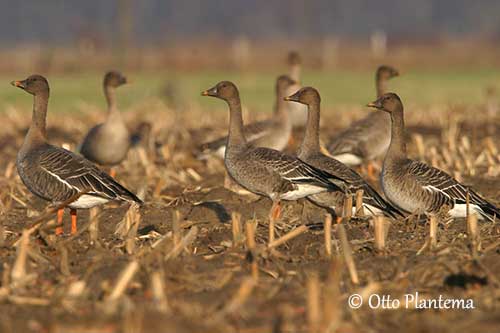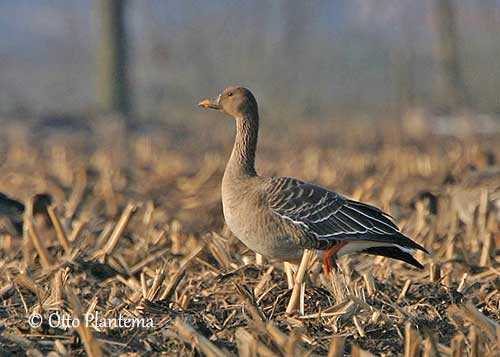
Fr: Oie des moissons
Ang: Taiga Bean Goose
All: Saatgans
Esp: Ánsar Campestre
Ita: Oca granaiola della taiga
Nd: Taigarietgans
Sd: tajgasädgås
Photographers:
Didier Buysse
Vision d’Oiseaux
Ken Havard
My Bird Gallery & Flickr gallery 1 & Flickr gallery 2
Otto Plantema
Trips around the world
Text by Nicole Bouglouan
Sources:
HANDBOOK OF THE BIRDS OF THE WORLD vol 1 by Josep del Hoyo-Andrew Elliot-Jordi Sargatal - Lynx Edicions - ISBN: 8487334105
THE HANDBOOK OF BIRD IDENTIFICATION FOR EUROPE AND THE WESTERN PALEARCTIC by Mark Beaman, Steve Madge - C. Helm - ISBN: 0713639601
GUIDE DES CANARDS, DES OIES ET DES CYGNES – de Steve Madge - Delachaux et Niestlé - ISBN: 2603013769
THE COMPLETE BOOK OF BRITISH BIRDS – Written by “Royal Society for the Protection of Birds” experts - Préface de Magnus Magnusson - Michael Cady- Rob Hume Editors - ISBN: 0749509112
A Field Guide to the Birds of South-East Asia by Craig Robson. New Holland Publishers. ISBN: 9781780090498
Animal Diversity Web (University of Michigan Museum of Zoology)
Bird Web (Seattle Audubon Society)
Birds of Britain - The Web Magazine for Birdwatchers
Wikipedia, the free encyclopaedia
Taiga Bean Goose
Anser fabalis
Anseriformes Order – Anatidae Family
INTRODUCTION:
The Taiga Bean Goose is now a full species with three subspecies. It is very similar to the Tundra Bean Goose, although being smaller, with shorter bill. The breeding areas are in North Palearctic, but the wintering grounds extend from Europe, Iran, China, Korea and Japan to SE Asia. They frequent large rivers and lakes, and may occur in lowlands. They feed on a wide variety of plant materials including leaves, tubers and seeds of various plant species. They are monogamous with long-term pair bonds. Both adults share the nesting duties.
The Taiga Bean Goose is threatened by habitat degradation, poisoning by pesticides and climate change on the breeding grounds. The population is decreasing, but the species is currently not globally threatened.
DESCRIPTION OF THE BIRD:
Biometrics:
Length: 66-89 cm
Wingspan: 140-200 cm
Weight (nominate race): M: 2690-4060 g – F: 2210-3470 g
The Taiga Bean Goose has brown head and back, whereas neck and breast are much paler brown. On the underparts, the belly is white but breast, wing bow and thighs are white with pale brown barring. The underwing is all-dark.
On the upperwing, the brown feathers are edged and tipped white, creating narrow white lines along the back. The tail feathers are similar.
The bill is black with pale orange subterminal band. The eyes are dark brown. Legs and feet are orange.
Male and female have similar plumage, but the male is larger than female.
The juvenile resembles adult but it has paler and duller plumage with less barring.

SUBSPECIES AND RANGE:
The Taiga Bean Goose has three subspecies.
A.f. fabalis (described above) breeds from Scandinavia E to Ural Mts. It winters in W, C and SE Europe and extreme SW Asia.
A.f. johanseni breeds from Ural Mts E to L Baikal. It winters in Turkmenistan and Iran E to W China.
This race is intermediate between fabalis and middendorffii.
A.f. middendorffii breeds in E Siberia E of L Baikal. It winters from E China to Japan.
This race is larger, with longer neck and legs. The bill is more slender. The plumage frequently shows a gingery wash.
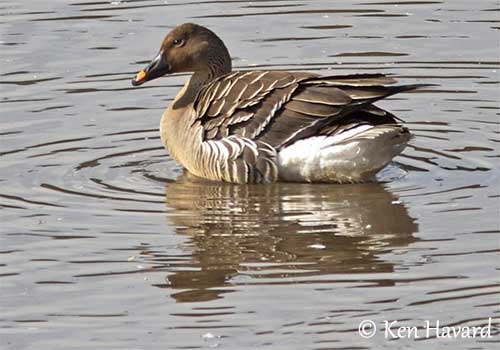
HABITAT:
The Taiga Bean Goose breeds in tundra and taiga habitats, usually near marshes and lakes. During winter, it frequents agricultural lands, lakes and marshes. The race johanseni occurs more often near lakes and marshes than other races, because food is more abundant in these habitats.
CALLS AND SONGS: SOUNDS BY XENO-CANTO
The Taiga Bean Goose gives prolonged resounding honks, higher-pitched towards the end and described as “unk unk”. The alarm call, also used in flight and as contact call, is a short, harsh note usually repeated 2-3 times.
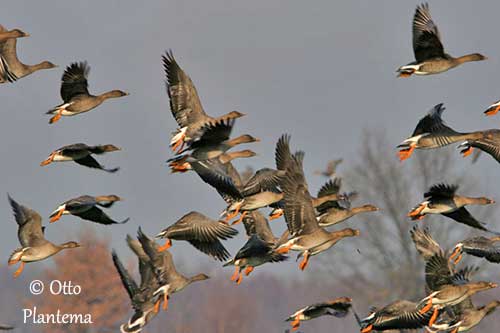
BEHAVIOUR IN THE WILD:
The Taiga Bean Goose feeds on plant materials such as grass, seeds, corn, rice, barley, wheat, soy beans, potatoes and sugar beets. The general diet includes grass, leaves, roots, tubers, seeds, grains and nuts.
It forages by walking on the ground, both in dry land and near lakes and marshes depending on the range and the season. They may form flocks of hundreds of birds, and join groups of mixed-species geese.
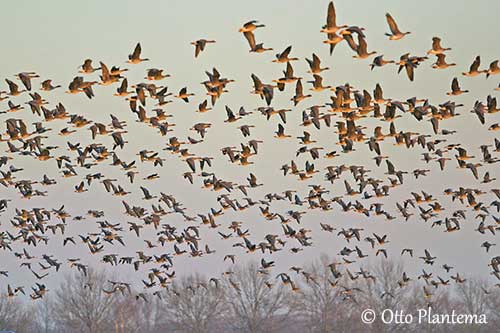
The Taiga Bean Goose defends aggressively the territory and displays three neck postures such as erect (vertical), diagonal and forwards. The latter posture often signals a coming fight.
The courtship displays last several weeks. They include flights of 3-4 geese together, or display of the tail feathers while the goose is swimming. Then, both members of the pair perform the “triumph ceremony” once the pair is formed. Both birds extend their necks while their heads become close to each other, and they sing. This behaviour is also used to renew the pair bond. They are monogamous.
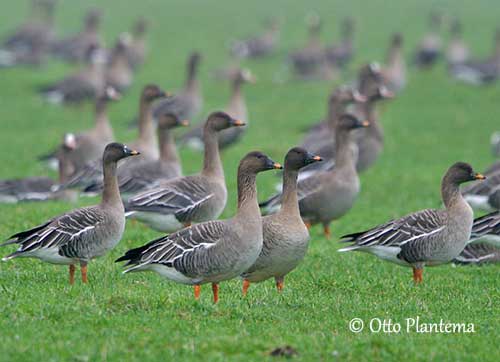
The Taiga Bean Goose is migratory and breeds on northern Palearctic. It winters in Europe, Iran, NW, C and E China, N and S Korea, Japan to SE Asia.
It is rare but regular visitor to the Aleutians and the Bering Sea region of Alaska during the return migration in spring.
The Taiga Bean Goose has strong, direct flight with powerful, steady wingbeats.
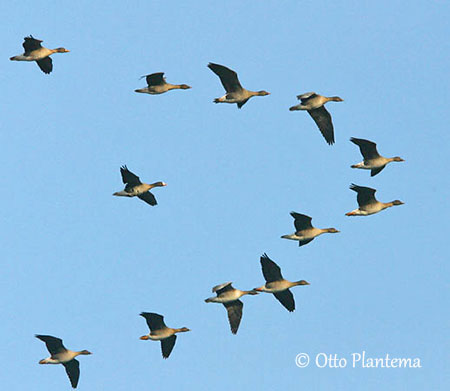
REPRODUCTION OF THIS SPECIES:
The breeding season starts in May-June, but the laying depends on weather conditions.
The Taiga Bean Goose nests on the ground, usually 50-100 centimetres above the surface, on hummocks safe from flooding. The nest is made with vegetation found in the vicinity of the nest-site.
The female lays 4-6 whitish eggs and the incubation lasts 27-29 days. The young follow their parents for feeding. They fledge about 40 days after hatching, but they still depend on adults for several weeks. They are sexually mature at 2-3 years old.

PROTECTION / THREATS / STATUS:
The Taiga Bean Goose is considered widespread, but it is threatened by degradation of the habitat caused by oil pollution, pesticides, drainage and changing management practices leading to scrub over-growth, and forest clearance in breeding areas in Russia, Norway and Sweden. Climate change and human persecution are also important problems.
The global population is estimated to number 680,000/800,000 individuals and the overall trend is decreasing.
However, the Taiga Bean Goose is not globally threatened and currently evaluated as Least Concern.
